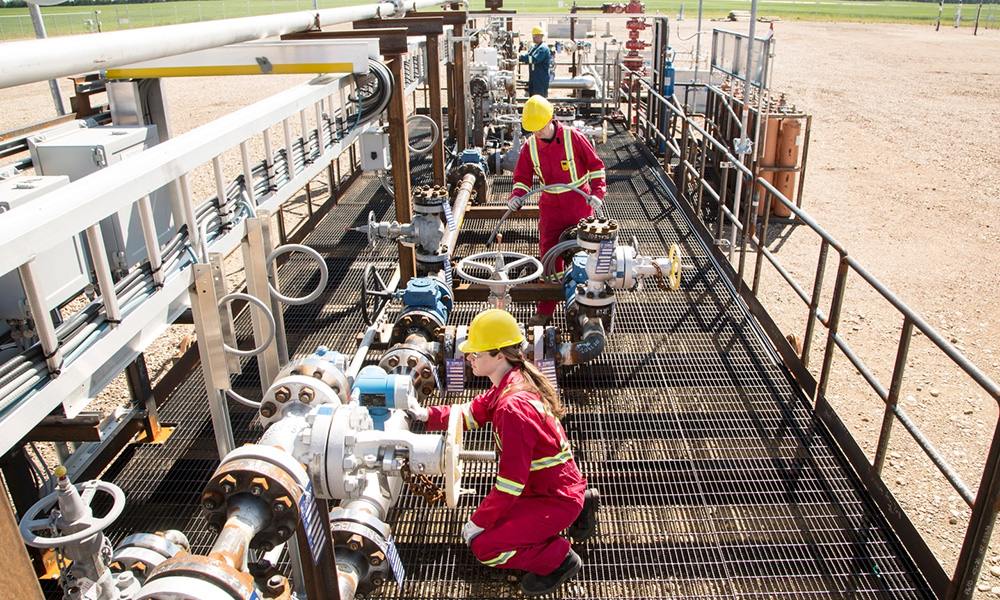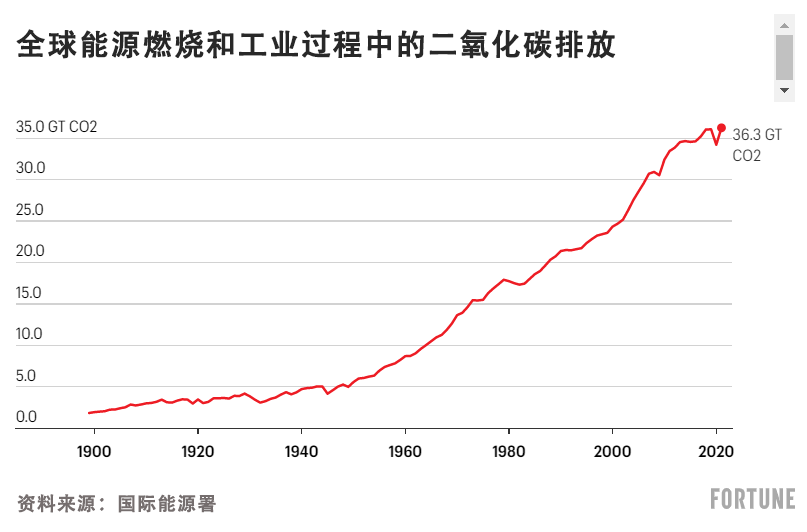
化石燃料公司正在积极推动一种气候变化解决方案,尽管得到多国政府的支持,但由于无法实现净零目标而一直受到批评。
通过碳捕获与封存(CCS)技术,使用化石燃料的行业可以捕获碳排放,并通过管道、卡车或船舶运输后地质封存。二氧化碳注入通常一公里或更深的地下岩层中。
壳牌(Shell)、英国石油公司(BP)、康菲石油(ConocoPhillips)和埃克森美孚(Exxon Mobil)都在研究该技术。埃克森美孚估计,到2050年,该技术的市场规模将达到4万亿美元。
其中壳牌在CCS技术方面比较领先,2008年以来一直在积极开发。仅在2020年,壳牌就为该技术花费了7,000万美元,也将CCS加入了不断扩大的能源投资组合。壳牌一直宣称CCS是可持续发展努力的关键。该公司的《2019年可持续发展报告》(Sustainability Report 2019)指出,还在探索捕获二氧化碳后的利用方式。
“要想实现2050年将能源产品净碳足迹(Net Carbon Footprint)减少一半左右的目标,也与全社会努力实现《巴黎协定》(Paris Agreement)大力减少温室气体排放保持同步,这些都是重要步骤。”报告指出。

各国政府为推进气候变化战略,也在大力投资CCS技术。美国的能源部(Department of Energy)为2021年总统乔·拜登签署两党基础设施建设法案中的碳捕获技术拨款超过23亿美元。英国已经在该技术领域投资了约11亿美元,也是其实现净零排放的关键。今年7月,欧盟委员会(European Commission)宣布,到2030年将为17个大型清洁技术项目投资18亿美元,其中也包括CCS项目。
相关投资均获得联合国政府间气候变化专门委员会(UN Intergovernmental Panel on Climate Change)认可。该组织在今年4月发布的一份报告中明确表示,CCS是大部分减排路径中关键的脱碳战略。
报告称:“新的生产工艺将利用低含量和零含量温室气体的电力、氢气、燃料,如此一来工业将逐步实现温室气体净零排放。而在掌握新化学方法之前,大幅降低水泥工艺排放将依赖已经商业化的水泥基材料替代物,以及CCS技术的利用程度。”
联合国政府间气候变化专门委员会表示,除了大幅减少化石燃料,“其他化石燃料系统中使用CCS技术”对于“实现净零二氧化碳能源系统”同样必要。
新冠疫情初期,随着煤炭消耗量和工业产出减少,碳排放量出现暂时性下降,然而几份报告显示,二氧化碳的排放量已经恢复上升趋势,2021年达到363亿吨,也是历史最高水平,种种迹象正在说明利用CCS技术的紧迫性。

尽管在实现2030年和2050年排放目标方面,CCS技术可能发挥重要作用,但很多气候倡导者质疑石油公司支持CCS的动机。尤其因为最近美国众议院监督委员会(House Oversight Committee)发布的文件显示,英国石油公司和壳牌的高管私下淡化对气候危机的公共承诺。
该委员会的文件称,英国石油公司一份内部备忘录中,强调了CCS技术“可在能源转型期及之后推动全面使用化石燃料”。
壳牌对CCS的投资
壳牌的CCS业务副总裁西里·克劳奇称,壳牌在近一个世纪之前便开始使用碳捕获技术。
克劳奇说:“壳牌自20世纪30年代以来便开始从被污染的流体中抽取二氧化碳。”其主要目的是从富含二氧化碳的物质中提取油、气。他解释道,在化石燃料销售和使用之前,根据技术指标要求,必须分离其中的二氧化碳。“然而,我们从那时开始便已经有了分离技术。”
壳牌公司在20世纪70年代便开发了首条运输二氧化碳的管道,从那时开始,公司便已经在使用二氧化碳来提升原油的开采率。将二氧化碳注入现有油田会提升其压力,有助于引导原油流向生产井。
在接下来的几十年期间,壳牌加大了CCS技术的研究和投资力度。公司在加拿大艾伯塔省埃德蒙顿附近设立了Quest CCS设施,而且与雪佛龙(Chevron)合作,在澳大利亚开展Gorgon CCS项目。这两个设施到目前为止共计储存了1,200多万吨的碳,相当于抵消了欧盟整个航空产业约8%的碳排放量。
壳牌还与挪威国家石油公司(Equinor)和法国道达尔公司(Total)成立了Northern Lights合资公司。这家公司为挪威CCS项目提供运输和存储服务,该项目是首个跨境开源二氧化碳运输和存储基础设施网络。9月,Northern Lights签署了商业协议,每年从荷兰氨气和化肥厂Yara Sluiskil将高达80万吨的二氧化碳运输至挪威西海岸海床,此举为寻求使用CCS技术的欧洲其他工业公司设立了新的标杆。
此外,壳牌计划在加拿大、欧洲和亚太地区另行修建至少十座工厂。
克劳奇说:“到2035年,我们计划实现2,500万吨二氧化碳的年度CCS能力。该技术在实现我们的气候抱负方面将发挥重要作用。”
这些抱负涉及的目标十分宽泛:壳牌承诺在2030年之前将其原油产量和二氧化碳排放减半,并在2050年之前实现净零排放。公司还预计,到2025年,其总开支的50%(现金资本支出和运营费用)将用于低碳和零碳产品和服务,包括氢气和生物燃料,电动汽车充电、基于自然的解决方案和CCS技术。
克劳奇称:“CCS技术有望帮助当前没有可扩展低碳替代方案的行业减少排放,尤其是那些难以消亡的行业,例如水泥、钢铁和化学品。”她还指出,这些行业的流程到目前为止贡献了近三分之一的全球二氧化碳排放量,需要采用CCS技术。
存在疑问的影响力
尽管政府以及像壳牌这样的公司希望大规模部署CCS项目,但有人认为该技术存在局限性。
能源经济学与金融分析研究所(Institute for Energy Economics and Financial Analysis)在9月发布的一则报告发现,相对于成功CCS项目的数量,表现不佳的CCS项目要多得多。
在该研究调查的13个项目中(约占当前全球55%的运营能力),有7个表现不佳,2个失败,1个处于关闭状态。
该报告的作者、能源经济学与金融分析研究所的能源金融分析师布鲁斯·罗伯逊表示:“很多国际机构和国家政府都依赖化石燃料领域的碳捕获来实现净零目标,但这一点根本行不通。尽管有证据表明该技术对于难以消亡的行业有一定的作用,比如水泥、化肥和钢铁,但总体结果显示,金融、技术和降排框架依然存在夸大成分,而且在表现方面不如预期。”
英国非政府组织全球见证(Global Witness)的资深活动家多米尼克·伊格尔顿提出了类似的观点。他说:“在过去30年,近86%用于减排的大规模碳捕获设施都以失败告终。碳捕获是一项失败的技术,而且正在抢夺真正气候解决方案所需的资源,例如可再生电力和能源效率。”
他提到了最近该组织对壳牌位于艾伯塔省Quest工厂的研究。报告称,尽管该设施自2015年以来已经阻止了500万吨二氧化碳排入大气,但却在同一时期排放了750万公吨的温室气体。壳牌则称这个发现“完全错误”。
伊格尔顿说:“有鉴于其复杂的基础设施,大多数碳捕获系统基本无法达到其标称的数量。因此,CCS对于实现2050年气候目标没有实质性的帮助。”
伊格尔顿认为,人们应该把重点放在可再生能源工厂。他说:“石油公司正在推广碳捕获,因为它能够让其继续开采、燃烧化石燃料并从中牟利,同时称其流程在某种程度上是环保的。”他还指出,对于CCS捕获的二氧化碳来说,一个可能的用途就是将其注入油井,从而开采更多的石油。
尽管他同意碳捕获与封存在帮助重工业脱碳方面是必要的,而且将发挥重要作用,但Climate Imperative Foundation的工业倡议主管阿尔·阿门达里兹亦不看好该技术。该机构的总部位于美国,致力于从事气候政策领域的工作。他对CCS技术的过往记录以及较高的运营成本表示担忧。CCS工厂往往都处于入不敷出的状态。
他说:“CCS并非是最有前途的技术,而且在减排方面也不是最具成本效益的方法,只能救救急罢了。”
持续的政府支持
尽管存在这些顾虑,政府对CCS的兴趣似乎注定呈增长态势。美国最近出台的《通胀削减法案》(Inflation Reduction Act)包含了2,600亿美元的清洁能源税优惠,而且将引导数百亿美元的资金进入CCS项目。评论人士对该法案在这一方面的做法提出了批评,称税收优惠其实就是针对化石燃料行业发放的补贴。
阿门达里兹称:“政府为CCS这类理念提供资金的目的是尝试打造必要的政治联盟,以便继续向前迈进。因此,与其说‘我们需要切断任何与化石燃料有关的支持,并将所有公共和私人投资注入零碳可再生技术’,各国政府认为,将一部分投资用于这类技术可以让本国或他国继续使用化石燃料,从政治上来讲更加便利。”
对壳牌而言,CCS只不过是公司开展持续能源转型举措的一个方面,而且克劳奇称,这也是十分必要的一个环节。
她说:“我们正在与客户合作,向其工厂交付低碳产品和脱碳选项。CCS必然会成为这一解决方案的一部分。”(财富中文网)
译者:冯丰
审校:夏林
化石燃料公司正在积极推动一种气候变化解决方案,尽管得到多国政府的支持,但由于无法实现净零目标而一直受到批评。
通过碳捕获与封存(CCS)技术,使用化石燃料的行业可以捕获碳排放,并通过管道、卡车或船舶运输后地质封存。二氧化碳注入通常一公里或更深的地下岩层中。
壳牌(Shell)、英国石油公司(BP)、康菲石油(ConocoPhillips)和埃克森美孚(Exxon Mobil)都在研究该技术。埃克森美孚估计,到2050年,该技术的市场规模将达到4万亿美元。
其中壳牌在CCS技术方面比较领先,2008年以来一直在积极开发。仅在2020年,壳牌就为该技术花费了7,000万美元,也将CCS加入了不断扩大的能源投资组合。壳牌一直宣称CCS是可持续发展努力的关键。该公司的《2019年可持续发展报告》(Sustainability Report 2019)指出,还在探索捕获二氧化碳后的利用方式。
“要想实现2050年将能源产品净碳足迹(Net Carbon Footprint)减少一半左右的目标,也与全社会努力实现《巴黎协定》(Paris Agreement)大力减少温室气体排放保持同步,这些都是重要步骤。”报告指出。
各国政府为推进气候变化战略,也在大力投资CCS技术。美国的能源部(Department of Energy)为2021年总统乔·拜登签署两党基础设施建设法案中的碳捕获技术拨款超过23亿美元。英国已经在该技术领域投资了约11亿美元,也是其实现净零排放的关键。今年7月,欧盟委员会(European Commission)宣布,到2030年将为17个大型清洁技术项目投资18亿美元,其中也包括CCS项目。
相关投资均获得联合国政府间气候变化专门委员会(UN Intergovernmental Panel on Climate Change)认可。该组织在今年4月发布的一份报告中明确表示,CCS是大部分减排路径中关键的脱碳战略。
报告称:“新的生产工艺将利用低含量和零含量温室气体的电力、氢气、燃料,如此一来工业将逐步实现温室气体净零排放。而在掌握新化学方法之前,大幅降低水泥工艺排放将依赖已经商业化的水泥基材料替代物,以及CCS技术的利用程度。”
联合国政府间气候变化专门委员会表示,除了大幅减少化石燃料,“其他化石燃料系统中使用CCS技术”对于“实现净零二氧化碳能源系统”同样必要。
新冠疫情初期,随着煤炭消耗量和工业产出减少,碳排放量出现暂时性下降,然而几份报告显示,二氧化碳的排放量已经恢复上升趋势,2021年达到363亿吨,也是历史最高水平,种种迹象正在说明利用CCS技术的紧迫性。
尽管在实现2030年和2050年排放目标方面,CCS技术可能发挥重要作用,但很多气候倡导者质疑石油公司支持CCS的动机。尤其因为最近美国众议院监督委员会(House Oversight Committee)发布的文件显示,英国石油公司和壳牌的高管私下淡化对气候危机的公共承诺。
该委员会的文件称,英国石油公司一份内部备忘录中,强调了CCS技术“可在能源转型期及之后推动全面使用化石燃料”。
壳牌对CCS的投资
壳牌的CCS业务副总裁西里·克劳奇称,壳牌在近一个世纪之前便开始使用碳捕获技术。
克劳奇说:“壳牌自20世纪30年代以来便开始从被污染的流体中抽取二氧化碳。”其主要目的是从富含二氧化碳的物质中提取油、气。他解释道,在化石燃料销售和使用之前,根据技术指标要求,必须分离其中的二氧化碳。“然而,我们从那时开始便已经有了分离技术。”
壳牌公司在20世纪70年代便开发了首条运输二氧化碳的管道,从那时开始,公司便已经在使用二氧化碳来提升原油的开采率。将二氧化碳注入现有油田会提升其压力,有助于引导原油流向生产井。
在接下来的几十年期间,壳牌加大了CCS技术的研究和投资力度。公司在加拿大艾伯塔省埃德蒙顿附近设立了Quest CCS设施,而且与雪佛龙(Chevron)合作,在澳大利亚开展Gorgon CCS项目。这两个设施到目前为止共计储存了1,200多万吨的碳,相当于抵消了欧盟整个航空产业约8%的碳排放量。
壳牌还与挪威国家石油公司(Equinor)和法国道达尔公司(Total)成立了Northern Lights合资公司。这家公司为挪威CCS项目提供运输和存储服务,该项目是首个跨境开源二氧化碳运输和存储基础设施网络。9月,Northern Lights签署了商业协议,每年从荷兰氨气和化肥厂Yara Sluiskil将高达80万吨的二氧化碳运输至挪威西海岸海床,此举为寻求使用CCS技术的欧洲其他工业公司设立了新的标杆。
此外,壳牌计划在加拿大、欧洲和亚太地区另行修建至少十座工厂。
克劳奇说:“到2035年,我们计划实现2,500万吨二氧化碳的年度CCS能力。该技术在实现我们的气候抱负方面将发挥重要作用。”
这些抱负涉及的目标十分宽泛:壳牌承诺在2030年之前将其原油产量和二氧化碳排放减半,并在2050年之前实现净零排放。公司还预计,到2025年,其总开支的50%(现金资本支出和运营费用)将用于低碳和零碳产品和服务,包括氢气和生物燃料,电动汽车充电、基于自然的解决方案和CCS技术。
克劳奇称:“CCS技术有望帮助当前没有可扩展低碳替代方案的行业减少排放,尤其是那些难以消亡的行业,例如水泥、钢铁和化学品。”她还指出,这些行业的流程到目前为止贡献了近三分之一的全球二氧化碳排放量,需要采用CCS技术。
存在疑问的影响力
尽管政府以及像壳牌这样的公司希望大规模部署CCS项目,但有人认为该技术存在局限性。
能源经济学与金融分析研究所(Institute for Energy Economics and Financial Analysis)在9月发布的一则报告发现,相对于成功CCS项目的数量,表现不佳的CCS项目要多得多。
在该研究调查的13个项目中(约占当前全球55%的运营能力),有7个表现不佳,2个失败,1个处于关闭状态。
该报告的作者、能源经济学与金融分析研究所的能源金融分析师布鲁斯·罗伯逊表示:“很多国际机构和国家政府都依赖化石燃料领域的碳捕获来实现净零目标,但这一点根本行不通。尽管有证据表明该技术对于难以消亡的行业有一定的作用,比如水泥、化肥和钢铁,但总体结果显示,金融、技术和降排框架依然存在夸大成分,而且在表现方面不如预期。”
英国非政府组织全球见证(Global Witness)的资深活动家多米尼克·伊格尔顿提出了类似的观点。他说:“在过去30年,近86%用于减排的大规模碳捕获设施都以失败告终。碳捕获是一项失败的技术,而且正在抢夺真正气候解决方案所需的资源,例如可再生电力和能源效率。”
他提到了最近该组织对壳牌位于艾伯塔省Quest工厂的研究。报告称,尽管该设施自2015年以来已经阻止了500万吨二氧化碳排入大气,但却在同一时期排放了750万公吨的温室气体。壳牌则称这个发现“完全错误”。
伊格尔顿说:“有鉴于其复杂的基础设施,大多数碳捕获系统基本无法达到其标称的数量。因此,CCS对于实现2050年气候目标没有实质性的帮助。”
伊格尔顿认为,人们应该把重点放在可再生能源工厂。他说:“石油公司正在推广碳捕获,因为它能够让其继续开采、燃烧化石燃料并从中牟利,同时称其流程在某种程度上是环保的。”他还指出,对于CCS捕获的二氧化碳来说,一个可能的用途就是将其注入油井,从而开采更多的石油。
尽管他同意碳捕获与封存在帮助重工业脱碳方面是必要的,而且将发挥重要作用,但Climate Imperative Foundation的工业倡议主管阿尔·阿门达里兹亦不看好该技术。该机构的总部位于美国,致力于从事气候政策领域的工作。他对CCS技术的过往记录以及较高的运营成本表示担忧。CCS工厂往往都处于入不敷出的状态。
他说:“CCS并非是最有前途的技术,而且在减排方面也不是最具成本效益的方法,只能救救急罢了。”
持续的政府支持
尽管存在这些顾虑,政府对CCS的兴趣似乎注定呈增长态势。美国最近出台的《通胀削减法案》(Inflation Reduction Act)包含了2,600亿美元的清洁能源税优惠,而且将引导数百亿美元的资金进入CCS项目。评论人士对该法案在这一方面的做法提出了批评,称税收优惠其实就是针对化石燃料行业发放的补贴。
阿门达里兹称:“政府为CCS这类理念提供资金的目的是尝试打造必要的政治联盟,以便继续向前迈进。因此,与其说‘我们需要切断任何与化石燃料有关的支持,并将所有公共和私人投资注入零碳可再生技术’,各国政府认为,将一部分投资用于这类技术可以让本国或他国继续使用化石燃料,从政治上来讲更加便利。”
对壳牌而言,CCS只不过是公司开展持续能源转型举措的一个方面,而且克劳奇称,这也是十分必要的一个环节。
她说:“我们正在与客户合作,向其工厂交付低碳产品和脱碳选项。CCS必然会成为这一解决方案的一部分。”(财富中文网)
译者:冯丰
审校:夏林
Fossil fuel companies are leading the way when it comes to a climate change solution that, despite its backing from multiple governments, has faced criticism as an ineffective way to reach net zero.
Carbon capture and storage (CCS) allows industries that burn fossil fuels to trap carbon emissions and transport them via pipelines, trucks, or ships for geological storage. The carbon dioxide is injected underground into rock formations, usually at depths of one kilometer or more.
Shell, BP, ConocoPhillips, and Exxon Mobil have all been working on the technology, which Exxon Mobil estimates will be a $4 trillion market by 2050.
As the leader of the pack when it comes to CCS, Shell has been extensively developing the technology since 2008. It spent around $70 million on the technology in 2020 alone, making CCS an integral part of its expanding energy portfolio. The company has been promoting CCS as a key part of its sustainability efforts. Its Sustainability Report 2019 notes that the company is also exploring ways to utilize CO2 once it has been captured.
“These are crucial steps to help us achieve our ambition to reduce the Net Carbon Footprint of the energy products we sell by around half by 2050, in step with society’s drive to re Net Carbon Footprint duce greenhouse gas emissions as it moves towards the goals of the Paris Agreement,” the report states.
Governments are making big investments in CCS as part of their climate change strategies as well. In the U.S., the Department of Energy is taking the first steps to disburse more than $2.3 billion for carbon capture technology included in the bipartisan infrastructure law President Joe Biden signed last year. The U.K. has invested about $1.1 billion in the technology, making it a key part of its net-zero scheme. And the European Commission announced in July that it will invest $1.8 billion toward 17 large-scale cleantech projects, including CCS efforts, by 2030.
These investments come with an endorsement by the UN Intergovernmental Panel on Climate Change (IPCC): In a report published in April, the organization made clear that CCS is a critical decarbonization strategy in most mitigation pathways.
“Progressing towards net-zero GHG emissions from industry will be enabled by the adoption of new production processes using low and zero GHG electricity, hydrogen, fuels, and carbon management,” the report reads. “Until new chemistries are mastered, deep reduction of cement process emissions will rely on already commercialized cementitious material substitution and the availability of CCS.”
Besides a substantial reduction in fossil fuels, “use of CCS in the remaining fossil system” will be necessary to “achieve net-zero CO2 energy systems,” according to IPCC.
This is especially true given that after a temporary dip in carbon emissions during the early stages of the coronavirus pandemic as coal consumption and industrial output dipped, several reports have shown that CO2 has resumed its upwards trajectory, reaching 36.3 billion tonnes last year—the highest level in history.
While CCS might play a significant role in reaching 2030 and 2050 emission goals, many climate advocates question the motivations of the oil companies supporting it—especially in light of recently released documents by the House Oversight Committee that suggest executives at BP and Shell have privately downplayed public commitments on the climate crisis.
An internal BP memo highlighted how CCS could “enable the full use of fossil fuels across the energy transition and beyond," per the committee.
Shell’s investment in CCS
Shell began using carbon capture technology nearly a century ago, according to Syrie Crouch, vice president of CCS at Shell.
“Shell has been taking CO2 out of contaminated streams since the 1930s,” Crouch said. That was mainly to extract gas or oil with a high CO2 content, which had to be removed to meet technical specifications before both fossil fuels were sold and used, she explained. “But we have had the separation technology for that long.”
The corporation developed the first pipeline to move carbon dioxide in the 1970s, and it’s then that it began utilizing CO2 for enhanced oil recovery. Injecting CO2 into existing oil fields increases pressure and helps direct oil toward production wells.
In the intervening decades, Shell has stepped up research and investment in CCS. It operates the Quest CCS facility near Edmonton in Alberta, Canada, and is a partner with Chevron in the Gorgon CCS in Australia. Combined, those facilities have stored over 12 million tons of carbon to date, the equivalent to removing about 8% of the emissions from the EU’s entire aviation industry.
Shell is also part of the Northern Lights joint venture with Norwegian energy company Equinor and French company Total. The venture is the transport and storage component of Norway's CCS project—the first ever cross-border, open-source CO2 transport and storage infrastructure network. In September, Northern Lights signed a commercial agreement to transport up to 800,000 tons of carbon dioxide annually from Yara Sluiskil, an ammonia and fertilizer plant in the Netherlands, to a seabed off the coast of western Norway, setting a new standard for other industrial companies across Europe looking to use CCS technology.
Further, Shell plans to build at least 10 more plants across Canada, Europe, and the Asia Pacific.
“We are seeking to get access to an additional 25 million tons of CO2 per year of CCS capacity by 2035,” Crouch said. “The technology plays an essential role in achieving our climate ambitions.”
Those ambitions span a far-reaching set of goals: Shell has pledged to reduce its oil output and cut its carbon dioxide emissions in half by 2030, and it aims to be net zero by 2050. It also expects 50% of its total expenditures (cash capital expenditure and operating expenses) to be on low- and zero-carbon products and services by 2025, from hydrogen and biofuels to charging for electric vehicles, nature-based solutions, and CCS.
“CCS has the potential to reduce emissions where there are no currently scalable low-carbon alternatives,” Crouch said, “particularly within hard-to-abate sectors like cement, steel, iron, and chemicals.” For those industrial processes—which, as of today, are responsible for nearly a third of global CO2 emissions—“a range of CCS is required,” she added.
A questionable impact
While governments and companies like Shell aim to deploy CCS at large scale, some believe the technology has its limits.
A Institute for Energy Economics and Financial Analysis (IEEFA) report published in September found that underperforming CCS projects considerably outnumbered successful ones by large margins.
Among the 13 projects examined for the study—around 55% of the total current operational capacity worldwide—seven underperformed, two failed, and one was mothballed.
“Many international bodies and national governments are relying on carbon capture in the fossil fuel sector to get to net zero, and it simply won’t work,” said Bruce Robertson, the report’s author and an energy finance analyst at IEEFA. “Although [there is] some indication it might have a role to play in hard-to-abate sectors such as cement, fertilizers, and steel, overall results indicate a financial, technical, and emissions-reduction framework that continues to overstate and underperform.”
Dominic Eagleton, senior campaigner with the U.K.-based NGO Global Witness, shared a similar view. “Over the past 30 years, almost 80% of large-scale carbon capture facilities that were designed to reduce emissions have failed,” he said. “Carbon capture is a failing technology that is taking resources away from genuine climate solutions such as renewable power and energy efficiency.”
He pointed to a recent Global Witness study on Shell’s Quest plant in Alberta. It states that while 5 million tons of carbon dioxide had been prevented from escaping into the atmosphere at the plant since 2015, that same plant also released 7.5 million metric tons of greenhouse gases over the same period. Shell dismissed the findings as “simply wrong.”
“Because of their complicated infrastructure, most carbon capture systems simply do not capture the volume of carbon that they say they’re going to capture,” Eagleton said. “To that end, CCS doesn’t really offer a meaningful contribution to the 2050 climate targets.”
Eagleton believes renewable energy plants should be given priority instead. “Oil companies are promoting carbon capture because it allows them to carry on extracting, burning, and making profits from fossil fuels, while claiming this is somehow climate friendly,” he said, noting that a possible use for the CO2 that’s captured through CCS is to inject it into oil wells as a method of extracting more petroleum.
While he agreed that carbon capture and storage is necessary and critical to help decarbonize heavy industries, Al Armendariz, industrial initiative director for the Climate Imperative Foundation, a U.S.-based organization working within the climate policy space, also isn’t optimistic about the technology, citing concerns about its track record and high operating cost. A CCS plant usually requires more money than it earns.
"CCS isn’t the most promising technology, and it isn't the most cost effective way to reduce emissions,” he said. “It only provides a lifeline.”
Ongoing government support
Despite these concerns, government interest in CCS seems destined to grow. The recently enacted Inflation Reduction Act included $260 billion in clean energy tax credits and will steer tens of billions of dollars into CCS projects. Critics have criticized this aspect of the law, saying that the tax credits are essentially a giveaway to the fossil fuel industry.
“Governments are giving money to ideas like CCS to try to build the necessary political coalitions to move forward,” Armendariz said. “So rather than saying ‘We need to cut off any support connected to fossil fuels and move 100% of our public and private investment into zero-carbon renewable technologies,’ they have decided that it's politically more convenient to give a certain amount of that investment to the technologies that will allow them—us—to continue using fossil fuels.”
For Shell, CCS is just one aspect of the company’s efforts to participate in the ongoing energy transition—and Crouch says that it is a necessary one.
“'We are working with our customers to deliver lower carbon products and decarbonization options to their facilities,” she said. “CCS has to be part of the solution.”






